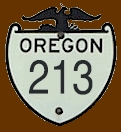

|
|
|||||||||||||
|
Other Local History Links The Community of Liberal, Oregon Wilhoit Mineral Springs History Page
Victor Hugo Dunton House (1916) |
In January of 1914, a company that had been floundering since its formation in early 1911 - the Clackamas Southern Railway Company - was reorganized as the Willamette Valley Southern Railway Company. Only three months later, in April, the assets of the company were taken over by the Portland Railway Light and Power Company. It was set up as a subsidiary of their interurban division. The company took out a new $3,000,000 mortgage to guarantee a $700,000 bond issue and used it to road. The Clackamas Southern had only created six miles in the nearly three years of their existence. They completed work and the line was opened for service from Oregon City to Mount Angel via Molalla on October 23, 1915, a distance of 31.02 miles. A proposed spur to Wilhoit Mineral Springs was never realized. As reported to the Governor, the total cost of building and equipping the line was $1,895,146. Included in the railway's inventory were four closed passenger cars, one electric locomotive, and two combination closed / open passenger cars. The Willamette Valley Southern Railway used 50 ton, 1,200 volt locomotives developing a tractive effort of 14,800 pounds at a speed rating of 10.8 miles per hour. This was typical equipment for this kind of medium service line.[3] Unfortunately, the largely rural communities that the railroad served never quite supported the business. Timber stands in the area had not yet been fully developed so the railway's business had to rely on carrying passengers and freight. The population was small and passenger traffic minimal. Mail was carried. Agriculture was the main enterprise of the region. Potatoes, eggs, cream, poultry and meat were transported to Oregon City and Portland. For several years, railcars of apples were shipped to Portland. However, below zero temperatures in the winter of 1919 killed much of the apple orchards in the area and ended that lucrative trade. The train passed by several of our ancestors farms and businesses. The owner of the Liberal Store, Uncle Bill Vick[1], would regularly take his 1910 Buick to the North Liberal station to pick up supplies for the store. And for a time (not sure of the dates) the store was also the Liberal, Oregon post office. As the train passed through the homestead of my Schoenborn relatives, my Great-grandfather[2] harvested and loaded railcars with cordwood which was sold to the paper mill at the Willamette Falls in Oregon City. In 1927, a large company, the Eastern & Western Lumber Company of Portland, looked like they might be the saving grace of the failing line. They built a logging railroad spur into their forestland just south of Molalla and began shipping large quantities of logs early in 1927. With the promise of revenues from this new business, the nearly bankrupt railroad was reorganized into a new company called the Willamette Valley Railway Company. However, all hope faded when a fire burned through the timberlands owned by Eastern & Western in September of 1929. In May of 1930, the track between Kaylor (southwest of Molalla) to Mount Angel was abandoned which shortened the line to 20.5 miles. The Southern Pacific Railway had constructed a spur from Canby to Molalla in 1912 in response to the creation of this line in 1911. [Note: This spur is still partially in operation as the Oregon Pacific Railroad.] As the Willamette Valley Railway was failing in the early 1930s, there was talk of the Southern Pacific purchasing it. It is presumed that if it has been better adapted for steam locomotives, the sale may have occurred. When the Eastern & Western logging operations stopped, so too did the Willamette Valley Railway. Lacking capital and any prospect of hope, the company went bankrupt, the tracks and trestles were decommissioned, and the right-of-ways eventually reverted back to the original landholders.
Sources:
Notes:
|
||||||||||||
|
Copyright © 1996 - 2024 - Network Services Group |
|||||||||||||